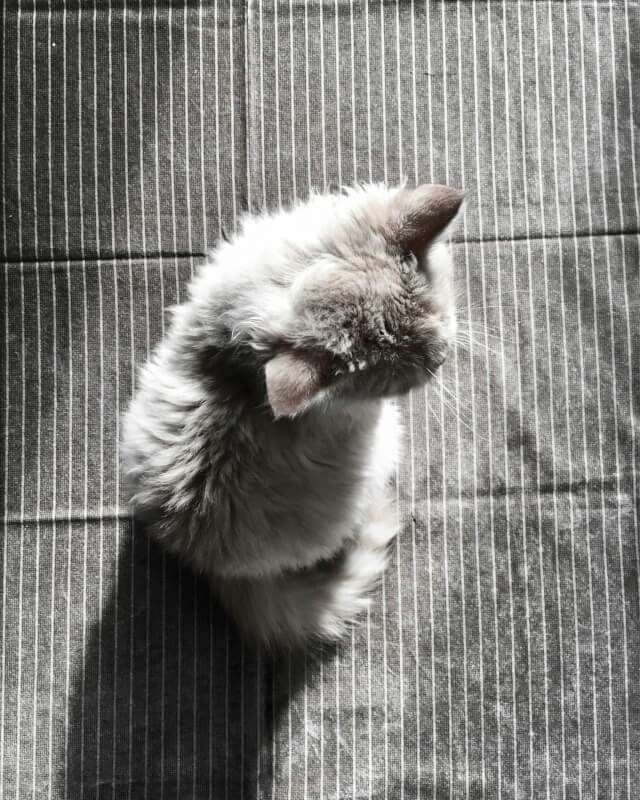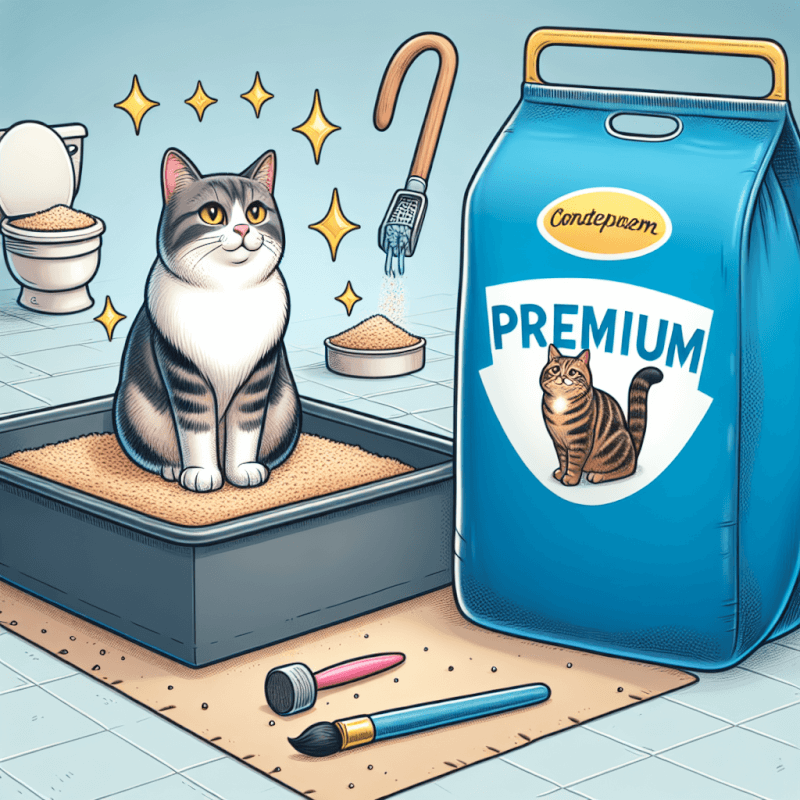Are you wondering how frequently you should change your cat’s litter? It’s an important question that every cat owner should ask. The cleanliness and freshness of your cat’s litter box can greatly impact their comfort and overall health. In this article, we will provide you with some helpful guidelines on how often you should change the cat litter to ensure a clean and safe environment for your feline friend. So, let’s get started and find out the answer to this common query!
Factors to Consider
When it comes to choosing the right cat litter for your furry friend, there are several factors that you should consider. These factors include the number of cats you have, the type of litter you prefer, the size of the litter box, your cat’s cleanliness habits, and odor control. By taking these factors into account, you can ensure that you provide a comfortable and clean litter environment for your cat.
Ready for Cat Trivia?
Test your knowledge about cats!

Number of cats
The number of cats you have in your household is an important factor to consider when choosing cat litter. If you have multiple cats, it’s important to choose a litter that can handle the increased demand. Some litters are specifically designed for multi-cat households and are more effective at controlling odors and clumps. Additionally, having multiple cats may require you to change the litter more frequently, as it can become dirty and smelly faster.
Type of litter
There are various types of cat litter available in the market, each with its own advantages and disadvantages. One popular option is scoopable litter, also known as clumping litter. This type of litter forms clumps when the cat urinates, making it easier to scoop out the waste. Non-scoopable litter, on the other hand, does not clump and requires the entire litter box to be changed more frequently. Eco-friendly litters are made from natural materials and are a great option for environmentally conscious pet owners. Finally, there are automatic litter boxes that automatically clean the litter, reducing the need for manual scooping.
Size of litter box
The size of the litter box is another factor to consider when choosing cat litter. Cats prefer spacious litter boxes where they can comfortably move and dig. The size of the litter box should be proportional to the size of your cat. If the litter box is too small, your cat may be more likely to have accidents outside the box or experience discomfort while using it. It’s important to choose a litter box that is large enough for your cat to move around freely.
Cat’s cleanliness
Some cats are naturally more clean and particular about their litter box than others. If your cat is particularly clean, they may require a litter that is more effective at controlling odors and clumps. It’s important to observe your cat’s behavior and preferences to determine the best litter for them. In some cases, you may need to experiment with different types of litter to find the one that your cat prefers.
Odor control
One of the most important factors to consider when choosing cat litter is odor control. Nobody wants their home to smell like a litter box, and the right litter can make a big difference in reducing odors. Scoopable litter is often recommended for its superior odor control as it clumps and traps the urine, preventing it from spreading throughout the litter box. However, some non-scoopable litters also have effective odor control properties. It’s important to choose a litter that is specifically designed to control odors and keep your home smelling fresh.
Scoopable Litter
Advantages
Scoopable litter, also known as clumping litter, offers several advantages that make it a popular choice among cat owners. One of the main advantages is its ability to form clumps when the cat urinates. This makes it easier to scoop out the waste, resulting in a cleaner and more hygienic litter box. Scoopable litter is also effective at controlling odors, as the clumps trap the urine and prevent it from spreading throughout the litter box. Additionally, scoopable litter tends to last longer than non-scoopable litter, as only the clumps need to be removed rather than changing the entire litter box.
Recommended frequency
In general, scoopable litter should be scooped at least once a day to maintain cleanliness and control odors. By removing the clumps on a daily basis, you can ensure that your cat has a fresh and clean litter box to use. However, if you have multiple cats, you may need to scoop more frequently to keep up with the increased demand. It’s important to monitor the cleanliness and odor of the litter box and adjust the scooping frequency accordingly.
Disadvantages
While scoopable litter offers numerous advantages, it also has its downsides. One disadvantage is that it can be more expensive than non-scoopable litter. Additionally, some scoopable litters may produce more dust, which can be problematic for cats with respiratory issues or allergies. It’s important to choose a scoopable litter that is low dust and safe for your cat. Finally, scoopable litter may not be suitable for kittens, as they may be more prone to ingesting the litter when they are exploring or playing in the litter box.

Non-Scoopable Litter
Advantages
Non-scoopable litter, also known as traditional litter, offers its own set of advantages for cat owners. One of the main advantages is its affordability. Non-scoopable litter is often more budget-friendly compared to scoopable litter, which can be a major consideration for some pet owners. Additionally, non-scoopable litter does not form clumps, making it easier to maintain a clean litter box. Some cats may also prefer the texture and feel of non-scoopable litter, as it closely resembles natural sand or dirt.
Recommended frequency
Non-scoopable litter should be completely changed and replaced regularly to ensure cleanliness and odor control. The frequency at which you should change the litter depends on various factors such as the number of cats, litter box size, and your cat’s cleanliness habits. In general, it is recommended to change non-scoopable litter every 3-5 days for a single cat household, and more frequently for multiple cats.
Disadvantages
While non-scoopable litter may be more affordable and require less frequent scooping, it does have its drawbacks. One of the main disadvantages is the lack of clumping, which can make it more difficult to remove the waste and maintain a clean litter box. Non-scoopable litter may also have inferior odor control compared to scoopable litter. Additionally, since the entire litter box needs to be changed more frequently, it can be more time-consuming and labor-intensive.
Eco-Friendly Litter
Advantages
Eco-friendly litter offers several advantages for environmentally conscious cat owners. These litters are typically made from natural materials such as recycled paper, wood, or corn-based products. One of the main advantages of eco-friendly litter is its biodegradability. Unlike traditional clay-based litters that can take hundreds of years to decompose, eco-friendly litters break down much faster and have a lower impact on the environment. Additionally, eco-friendly litters are often free from harmful chemicals and additives, making them safer for both your cat and the environment.
Recommended frequency
The recommended frequency for changing eco-friendly litter is similar to non-scoopable litter. Depending on the number of cats and their habits, it is generally recommended to completely change the litter every 3-5 days for optimal cleanliness and odor control. However, it’s important to follow the manufacturer’s guidelines for the specific eco-friendly litter you choose, as different brands may have slightly different recommendations.
Disadvantages
While eco-friendly litter has numerous advantages, it also has its own set of disadvantages. One of the main disadvantages is its potential cost. Eco-friendly litters tend to be more expensive compared to traditional litters, which can be a significant factor for some pet owners. Additionally, certain eco-friendly litters may not have the same clumping or odor control capabilities as traditional litters. It’s important to choose an eco-friendly litter that meets your cat’s needs while also considering your budget and environmental impact.

Automatic Litter Boxes
Advantages
Automatic litter boxes offer a convenient and hassle-free solution for cat owners. These litter boxes are designed to automatically clean the litter, eliminating the need for manual scooping. One of the main advantages of automatic litter boxes is their ability to reduce odor. The boxes often have built-in mechanisms that separate the waste from the clean litter and seal it in a separate compartment, minimizing the spread of odors. Automatic litter boxes also provide a clean and fresh litter box for your cat at all times, which can be beneficial for their hygiene and overall comfort.
Recommended frequency
The recommended frequency for maintaining an automatic litter box depends on the specific model and manufacturer guidelines. In general, it is recommended to check and empty the waste compartment regularly to ensure efficient operation. Most automatic litter boxes have indicators or alerts to notify you when the waste compartment needs to be emptied. It’s important to follow the manufacturer’s recommendations to ensure the longevity and effectiveness of the automatic litter box.
Disadvantages
While automatic litter boxes offer convenience, they may not be suitable for every cat and owner. One of the main disadvantages is the initial cost of purchasing an automatic litter box, which can be higher compared to traditional litter boxes. Additionally, some cats may be hesitant or scared to use an automatic litter box, especially if they are not familiar with the noise or movement. It’s important to introduce your cat to the automatic litter box gradually and provide positive reinforcement to encourage their use. Furthermore, automatic litter boxes require regular maintenance and cleaning to ensure proper functionality, which can be a time-consuming task for some pet owners.
Signs It’s Time to Change
To determine when it’s time to change your cat’s litter, there are several signs that you should look out for. These signs indicate that the litter is no longer clean or effective at controlling odors. By recognizing these signs, you can ensure that your cat has a clean and comfortable litter box environment.
Visible waste
One of the most obvious signs that it’s time to change the litter is the presence of visible waste in the litter box. If you notice that the litter is significantly soiled or contains solid waste, it’s a clear indication that the litter needs to be changed. Removing the waste promptly is essential for maintaining cleanliness and preventing odor buildup.
Strong odor
Another sign that it’s time to change the litter is a strong and unpleasant odor coming from the litter box. While some odor is normal, a particularly strong and persistent smell indicates that the litter is no longer effectively controlling odors. This can be especially problematic in households with multiple cats or in small living spaces. Changing the litter more frequently or switching to a litter with better odor control properties can help address this issue.
Clumps sticking to the box
If you notice that the clumps formed by scoopable litter are sticking to the sides or bottom of the litter box, it’s a sign that the litter is not performing well. Clumps should easily separate from the litter box when scooped, indicating that the litter is capable of forming solid clumps. When clumps stick to the box, it can make scooping more difficult and result in a messier litter box environment.
Decreased usage
If you observe that your cat is avoiding the litter box or using it less frequently, it may be a sign that the litter needs to be changed. Cats are naturally clean animals and may develop aversions to a dirty or smelly litter box. By monitoring your cat’s litter box habits, you can identify any changes in usage patterns and take appropriate action.

Extra Tips for Odor Control
Maintaining a fresh and odor-free litter box environment is important for both you and your cat. Here are some extra tips to help control odors and keep your home smelling clean:
Frequent scooping
Regularly scooping the litter and removing clumps is essential for controlling odors. By scooping at least once a day, you can prevent the urine from spreading throughout the litter box and minimize odor buildup.
Baking soda
Sprinkling a thin layer of baking soda on top of the litter can help absorb and neutralize odors. Baking soda is a natural deodorizer and can be an effective addition to your odor control routine.
Activated charcoal
Using litter that contains activated charcoal can also help absorb odors and keep the litter box smelling fresh. Activated charcoal is known for its ability to trap and neutralize odors, making it a popular choice for odor control.
Scented litter
If you prefer a more pleasant scent in your home, scented litter is an option to consider. Scented litters come in various fragrances and can help mask unpleasant odors. However, it’s important to choose a scent that is not overpowering or irritating to your cat’s sensitive nose.
Conclusion
Choosing the right cat litter is an important decision that can greatly impact your cat’s comfort and your home’s cleanliness. Factors such as the number of cats, type of litter, size of the litter box, your cat’s cleanliness, and odor control should all be taken into consideration. Whether you opt for scoopable litter, non-scoopable litter, eco-friendly litter, or an automatic litter box, it’s important to monitor your cat’s habits and adjust the cleaning frequency as needed. By following the recommended guidelines and incorporating extra odor control tips, you can maintain a clean and pleasant litter box environment for your beloved feline companion.



